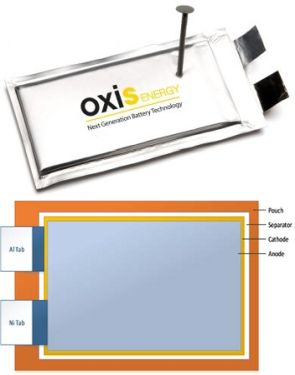The best commercial lithium-ion batteries today deliver energy densities of around 250 Wh/kg. But battery chemistry oriented around lithium-sulfur could deliver double that figure. This potential improvement has brought electric plane-maker Bye Aerospace in Colorado to work with UK-based Oxis Energy on LiS cells able to provide in excess of 500 Wh/kg at 20-Ah capacity. Bye says the resulting two-fold reduction in battery system weight can significantly boost the duration of electric-powered flight. The goal

The discharge cycle in a lithium-sulfur battery.
of the program is a 50% to 100% increase in flight time from a single charge. (However, Bye hasn’t specifically said what kind of flight times it is talking about. Its two-seat electric eFlyer 2 plane is still undergoing FAA certification testing.)
Lithium-sulfur battery technology is the focus of a European collaborative research effort called Alise. The Oxis cells are part of that effort. LiS cells can weigh less than comparable lithium-ion cells thanks to the moderate atomic weight of sulfur. The main problem with LiS technology so far has been too-low charge/recharge cycle life. The culprit is a polysulfide “shuttle” effect that causes the progressive leakage of active material from the cathode. Specfically, lithium polysulfide Li2Sx (6<x<8) dissolves in the common electrolytes used for LiS batteries. The polysulfides leak from the cathode and also corrode the lithium.  This shuttle effect causes self-discharge of LiS batteries. And there are other issues as well, including the fact that the sulfur cathode has an extremely low electrical conductivity that requires the use of a large amount of electrolyte, and the sulfur cathode expands appreciably during a discharge as it absorbs lithium.
This shuttle effect causes self-discharge of LiS batteries. And there are other issues as well, including the fact that the sulfur cathode has an extremely low electrical conductivity that requires the use of a large amount of electrolyte, and the sulfur cathode expands appreciably during a discharge as it absorbs lithium.
Oxis Energy claims it has a handle on all these issues to point where it is ready to setup the first-ever manufacturing plant for producing electrolyte and cathode active material

An Oxis Energy pouch cell. Presumably, commercial versions won’t have a nail through the pouch.
specifically for the mass production of lithium sulfur cells. The plant, in the UK, will supply the firm’s manufacturing plant in Brazil, located close to the a supply of lithium rock deposits. Oxis says the UK plant is currently at Manufacturing Readiness Level eight. (MRL is a measure developed by the US DoD to assess the maturity of manufacturing readiness. MRL 8 is defined as a readiness to begin low-rate production with manufacturing capabilities already demonstrated on a pilot line.)
One benefit of the Oxis cells is that they use a “safe,” non-flammable electrolyte that lengthens the life of the lithium metal. The company has produced cells in the form of pouches that deliver energy densities over 500 Wh/kg, keep working despite punctures and bullet holes, and last some 250 charge cycles. Oxis thinks its cells can hit 500 charge/recharge cycles and more within a couple of years.

Bye Aerospace eFlyer 2 now undergoing certification testing.
Bye Aerospace plans to test the new cells in existing and soon-to-be-announced Bye aircraft. Th e resulting data is expected to demonstrate the advantages of the Oxis LiS technology to the aerospace sector and more specifically, to Bye Aerospace’s future aviation applications. Bye’s initial plane is targeting roles in pilot training.
